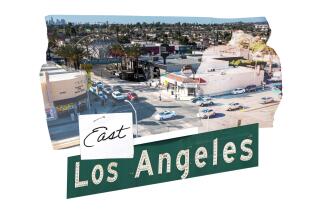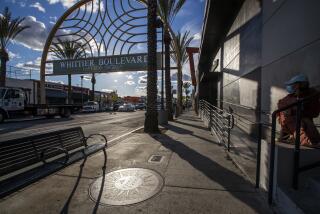Seattle Secession Threat Sounds Familiar
- Share via
SEATTLE — In this cloud-shrouded city on the banks of Puget Sound, there are two simple words that make most longtime residents cringe: Los Angeles.
So it is ironic that a fight over how to manage growth to keep Seattle from becoming like Los Angeles has sparked the same threat of secession currently heard in the San Fernando Valley.
The fight in Seattle even mirrors the Los Angeles debate in that a local lawmaker proposed a bill akin to the legislation Assemblywoman Paula Boland (R-Granada Hills) co-wrote to make secession in Los Angeles easier.
The call for secession has come from the idyllic suburb of West Seattle, where residents cite many of the same reasons for wanting a split that Valley residents do.
Both feel they don’t get their fair share of city services. Both feel City Hall doesn’t listen to them. And both say breaking away to form a more manageable-sized city may be the answer.
“We don’t see the investment in our neighborhood that we see downtown,” said Charlie Chong, a leader of the secession movement in West Seattle.
Although Seattle has about one-sixth the population of Los Angeles and prides itself on being one of America’s ideal cities, secession talk is an example of how appealing it is for disenchanted citizens to want to declare independence from a distant bureaucracy.
For example, secession fights are brewing across the country in areas such as Staten Island, western Kansas and Michigan’s Upper Peninsula.
In Seattle--as in Los Angeles--the talk of secession has forced city leaders to do some self-evaluation and consider changes in the way they govern.
“I think the lesson is that city officials can’t forget the rule that all politics are local and they need to talk to the people,” said Seattle Councilwoman Tina Podlodowski. Prompted by the secession threat, she proposed a plan to improve ties between elected officials and neighborhoods.
West Seattle’s secession movement, however, suffered a setback last year when Washington last year when Washington Gov. Mike Lowry vetoed the bill that would have made it easier for the community to secede, calling it impractical.
But residents of this conservative suburb have not given up the fight and say that, at the very least, the movement has forced City Hall to pay more attention to their complaints.
“They say you can’t beat City Hall, but we thought we at least got some respect,” said Chong, a self-described “retired federal bureaucrat.”
West Seattle is a community of about 75,000 middle- and high-income residents who live on a peninsula separated from the rest of Seattle by the Duwamish Waterway--like the San Fernando Valley is separated from Los Angeles by the Santa Monica Mountains.
But the feeling of separation is more than just geographical. West Seattle residents identify more closely with their community than with the rest of Seattle--just as many Valley residents say they are from the Valley as opposed to Los Angeles.
West Seattle residents think their core values are more conservative than the rest of Seattle, and they say they worry more about development spoiling their laid-back, small-town character.
That is why when the city of Seattle introduced a growth management plan two years ago that established guidelines for high-density “urban villages” with low-income housing in West Seattle, residents there howled in protest and threatened to secede. By breaking away, they argued, they could draft their own low-density development plan with more libraries and police services.
Ironically, city leaders tried to sell the plan by warning residents that without it Seattle could develop into another Los Angeles.
“It always drew a laugh when we said that,” said David Bley, an advisor to Seattle Mayor Norm Rice.
Many West Seattle residents did not laugh. They thought the plan would promote growth rather than control it.
But breaking away to form a new city is not easy in Seattle or Los Angeles. Washington law requires a 60% vote of approval by the entire city for an area like West Seattle to secede. In Los Angeles, the City Council can block a secession even if voters in an area such as the Valley support the idea overwhelmingly.
*
To make secession easier, Washington state Sen. Mike Heavey of West Seattle introduced a bill that would require only a 60% vote of approval in the area that wants to secede. Boland’s bill, which was passed by the Assembly and now awaits a vote in the Senate, would eliminate the City Council’s veto power.
To prevent wholesale secession movements throughout the state, the Heavey bill was written to apply only to Seattle. Boland’s bill applies only to Los Angeles.
Like Boland, Heavey said he drafted the bill not because he supports secession but because he believes the residents of West Seattle should have a fair shot at deciding their own fate.
“I don’t favor it,” he said of secession, “but I don’t think the current system is fair.”
Heavey said he has paid the price for trying to facilitate the vote. “I got wrung through the wringer like I had killed someone,” he said.
The strongest opposition came from the Seattle City Council and Mayor Rice, who said the idea of secession was impractical and would not solve the concerns raised by West Seattle residents.
And a city study prompted by the secession threat determined that West Seattle generates about 10% of the city’s tax base, even though it represents about 14% of its population.
Heavey’s bill made it through the state legislature but was vetoed by Lowry, who was heavily lobbied by the Seattle City Council to kill it.
Heavey has vowed to reintroduce the bill after Lowry is out of office.
Chong and other activists in West Seattle also are continuing the fight and now even talk about seceding from the county, under the premise they would have more control over planning as a separate governmental entity.
*
In an effort to make the City Council more accountable to residents, secessionists proposed electing council members by district instead of at large, but the plan was voted down at the polls.
As an alternative, the City Council adopted Podlodowski’s plan to create nine districts and make each council member responsible for an area. The council members are not required to live in the districts and are still elected at large.
A self-evaluation is also taking place in Los Angeles. Councilmen Mike Feuer and Richard Alarcon have instructed city staff to study possible changes in the way the city governs in response to secession talk in the Valley.
This is not the first time West Seattle has threatened to secede. A similar movement took root about two decades ago when residents felt the city was dragging its feet on repairing a drawbridge that was hit by a ferry, eliminating one of the main routes to downtown Seattle.
At that time, West Seattle residents also complained about the impact busing was having on the community--a complaint also raised in the 1970s in the San Fernando Valley.
In Seattle, city leaders acknowledge they must accept some blame for the secession threats.
“It’s clear that the movement started with a vocal minority, but the city erred by not responding more quickly,” said Seattle City Councilman Tom Weeks, who lives in West Seattle. “We said, ‘If we ignore them, they will go away.’ ”
He said it was also a mistake to let secessionists repeat their complaints without the city responding.
“Gradually a broader segment of West Seattle believed the arguments even though they are not true,” Weeks said.
Bley, the mayor’s advisor on intergovernmental relations, agrees.
“They did get our attention,” he said. “It taught us to go back and talk to the citizens.”
*
Despite the new attitude in Seattle City Hall, many residents say it is too little, too late.
No polls have been taken to gauge the support for secession in West Seattle, but a talk with residents and business owners on California Avenue--West Seattle’s main drag--demonstrates that many people support the idea even if they believe it will never come to pass.
At Rick’s Barber Shop, owner Rick Cook said he supports a secession movement because West Seattle has always felt “left out and pushed aside.” His main concern, he said, is that the city doesn’t do enough to maintain the roads in West Seattle.
But secession probably will never happen, Cook said, because setting up a new government would be too difficult.
Down the road a bit, at Poggie Tavern, a West Seattle institution since Prohibition, there have even been a couple of fistfights over the secession movement, according to the locals.
“I feel that the values of people downtown conflict with those of us who work for a living,” said Douglas Johnson, a retired aerospace worker and 44-year resident. He supports secession “if it means we will get a little more respect out here.”
Connie DeLadd, the manager, disagreed, saying West Seattle does not have the tax base to sustain its own government and police force.
Although she said the city hasn’t maintained roads well in West Seattle, DeLadd believes the threat of secession may have increased police protection.
“I think that the lesson paid off,” she said.
*
But Lloyd McIsaac, owner of Snubby’s restaurant a few blocks down the road, takes a more philosophic look at the movement.
He has lived in West Seattle for 36 years and has heard the threats before. While the secession movement may have forced City Hall to pay more attention to West Seattle, he wonders how long the attitude will last.
“There has to be another way,” McIsaac said. “How many times can you do that before they call your bluff?”
More to Read
Sign up for Essential California
The most important California stories and recommendations in your inbox every morning.
You may occasionally receive promotional content from the Los Angeles Times.














